Kingsnakes, known for their vibrant hues and bold patterns, are a family of nonvenomous constrictors. They possess a natural elegance and commanding presence that have fascinated herpetologists and nature enthusiasts alike. Found throughout various regions of North and Central America, different types of kingsnakes have earned their majestic title for their fearless disposition and regal appearance.
As we delve into the enchanting world of these slithering monarchs, we’ll encounter an assortment of kingsnake species, each with its unique features and habitats. From the striking California kingsnake, with its sleek black and white stripes, to the resplendent Eastern kingsnake, adorned with rich brown and black bands, there’s an astonishing variety to uncover. Let’s learn more about kingsnakes, shall we?
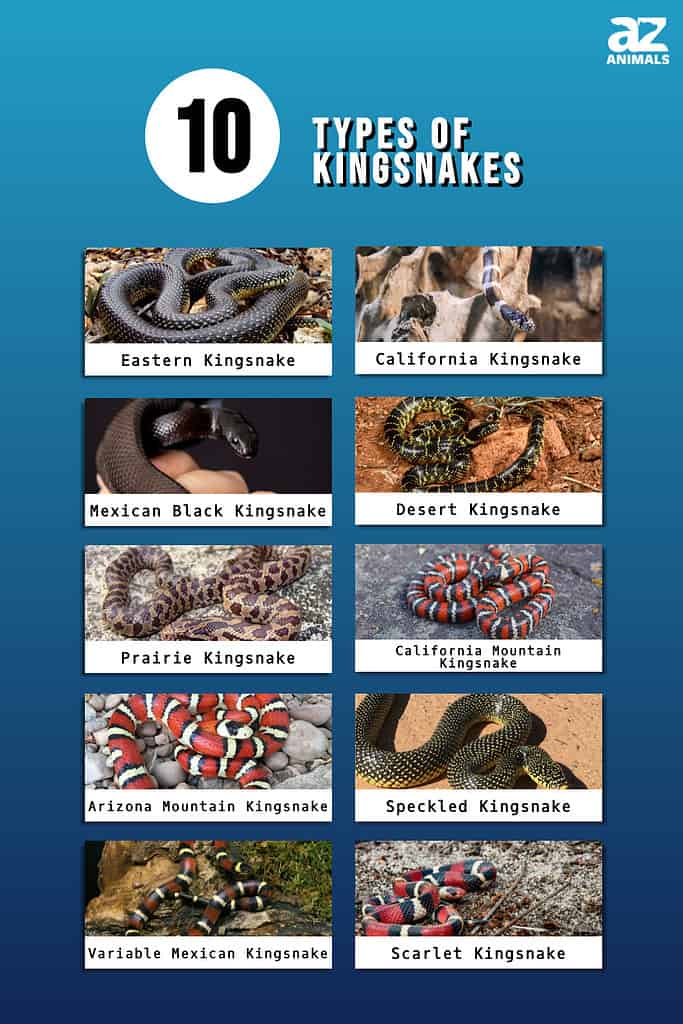
What is a Kingsnake?
Kingsnakes are a fascinating group of non-venomous snakes belonging to the genus Lampropeltis, which is part of the family Colubridae. These snakes are renowned for their striking patterns and diverse coloration, making them fascinating creatures to observe and study.
Classification
As members of the genus Lampropeltis, kingsnakes share a taxonomic family with other colubrid snakes. Within this genus, there are numerous species, each exhibiting unique patterns and habitats.
Appearance
Kingsnakes showcase a remarkable array of colors and patterns. Their bodies are often glossy, with a black or dark-colored base, adorned with vivid bands or stripes in contrasting colors. The specific patterns and colors vary significantly among species and even within populations, leading to their name “variable kingsnakes.”
Habitat and Distribution
Kingsnakes are found in diverse habitats across North and Central America. They are highly adaptable, occupying environments such as grasslands, forests, deserts, and mountains. Their distribution ranges from the southeastern United States to parts of Mexico and even into Central America.
Diet and Hunting
These snakes are proficient hunters with a broad diet. They are constrictors, using their strong coils to subdue and consume their prey. Kingsnakes have a preference for small mammals, such as rodents and birds, but they are opportunistic feeders and will also consume lizards, amphibians, and other snakes. Some kingsnake species are known for their ability to eat venomous snakes, thanks to their immunity to certain snake venoms.
Conservation Status
Kingsnakes, in general, are not considered endangered, but some species may face threats due to habitat destruction and road mortality. Proper conservation measures, including protecting their natural habitats and raising awareness about their ecological importance, are essential to ensure their continued presence in the wild.
With all of this in mind, let’s take a look at some cool kingsnake species!
1. Eastern Kingsnake
Classification: Lampropeltis getula

Eastern kingsnakes have a slightly speckled, yellow, and black pattern.
©Matt Jeppson/Shutterstock.com
The first on our list of types of kingsnakes is a very common species. The Eastern kingsnake is a captivating reptile native to various parts of the eastern United States. One of its distinguishing features is its striking patterns and markings. With a glossy black body, it boasts prominent white or yellowish bands that form an eye-catching chain-like pattern. This unique coloration serves as a warning to potential predators, mimicking the appearance of venomous snakes like the Eastern coral snake.
In terms of behavior, Eastern kingsnakes are skilled hunters with a varied diet. They feed on rodents, birds, eggs, and even other snakes, including venomous species. Interestingly, they are immune to certain snake venoms, allowing them to consume venomous snakes without harm. These snakes are primarily active during the night, seeking shelter during the day in burrows or under rocks to regulate their body temperatures.
When faced with threats, Eastern kingsnakes have defensive strategies to protect themselves. They may vibrate their tails, emit hissing sounds, and release a pungent musk to deter predators. However, their preference is to avoid confrontations and escape if possible.
Breeding takes place in the spring, and females lay eggs in concealed nests. The young snakes, born with similar markings to adults, become independent quickly and start hunting small prey.
2. California Kingsnake
Classification: Lampropeltis californiae
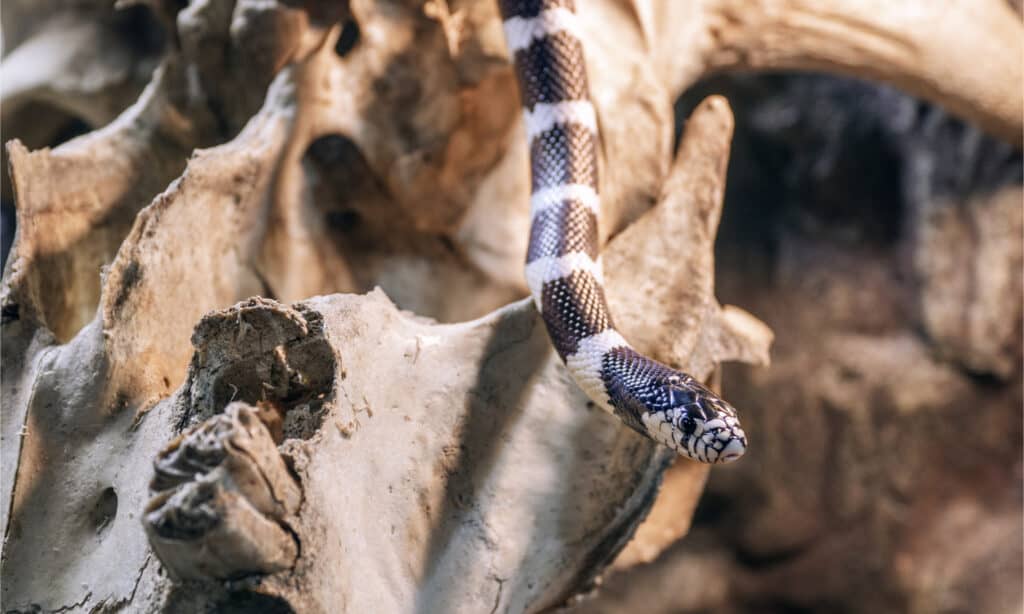
California kingsnakes are very easy to spot by their thick rings of black and white.
©Ann May Snz/Shutterstock.com
One of the most recognizable types of kingsnakes out there has to be this one! The California kingsnake is a fascinating snake found in various regions of California and neighboring states. Its patterns and markings make it stand out in the snake world. The kingsnake exhibits a sleek, shiny black body, adorned with bold, white, or cream-colored bands that encircle its length. These bands often form a distinctive chain-like pattern, which is why they are also called “chain kingsnakes.” This striking coloration serves as a warning to potential predators, resembling the appearance of venomous species like the coral snake.
California kingsnakes are known for their diverse behaviors. As skilled hunters, they have a varied diet, which includes rodents, birds, eggs, and other snakes. In a remarkable feat, they are immune to certain snake venoms, allowing them to safely consume venomous snakes.
These snakes are primarily active during the night, seeking shelter during the day to avoid extreme temperatures. When threatened, California kingsnakes resort to defensive strategies such as vibrating their tails, hissing, and emitting a strong-smelling musk.
3. Mexican Black Kingsnake
Classification: Lampropeltis getula nigrita
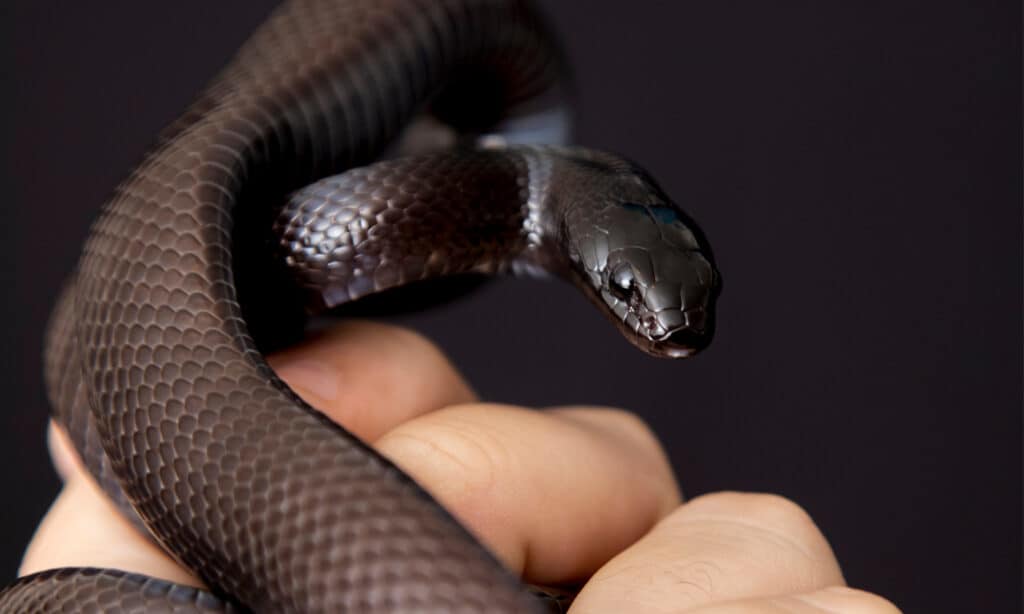
This kingsnake is usually jet black in appearance, making it easy to spot.
©iStock.com/Murilo Gualda
The Mexican black kingsnake is one of the most stunning types of kingsnakes native to Mexico and parts of the southwestern United States. Its appearance is distinguished by a striking pattern and coloration. The kingsnake’s body is glossy black, which provides a stunning contrast to its vibrant yellow or cream-colored bands that run horizontally along its length. These bands sometimes merge into chain-like patterns, making it an eye-catching reptile.
Mexican black kingsnakes are primarily nocturnal creatures, displaying a range of behaviors during their active hours. As proficient hunters, they prey on a variety of small animals, including rodents, birds, eggs, and other snakes. Interestingly, they are known for their immunity to certain venomous snake bites, allowing them to consume venomous species without harm.
When threatened, the kingsnake may adopt defensive tactics, such as coiling and vibrating its tail, to ward off potential predators. Additionally, they can release a musky scent to discourage predators from approaching.
During the breeding season, females lay eggs in concealed nests. The hatchlings are born with patterns similar to the adults and quickly begin their independent journey, honing their hunting skills.
4. Desert Kingsnake
Classification: Lampropeltis getula splendida

Desert kingsnakes have very vibrant yellow and black bodies.
©Jon Bolton/Shutterstock.com
The desert kingsnake is a visually beautiful reptile inhabiting arid regions of the southwestern United States and Mexico. Its appearance is marked by a distinctive pattern and coloration. The kingsnake’s body features a background color of pale cream or yellow, adorned with bold, dark brown or black bands that extend horizontally along its length. These bands may vary in width and sometimes merge into a chain-like arrangement, making it visually appealing.
Desert kingsnakes are predominantly nocturnal creatures, exhibiting various behaviors during their active hours. As adept predators, they possess a diverse diet that includes rodents, birds, lizards, and smaller snakes. They are constrictors, which means they subdue their prey by coiling around them until they succumb.
When faced with threats, desert kingsnakes may resort to defensive strategies such as vibrating their tails, hissing, or striking to deter predators. However, they are generally non-aggressive and prefer to escape from danger rather than confront it.
The desert kingsnake’s population is currently stable, but preserving its natural habitats and raising awareness about its ecological importance remain vital to safeguarding this remarkable species for future generations.
5. Prairie Kingsnake
Classification: Lampropeltis calligaster

Prairie kingsnakes might be harder to spot in the wild due to their camouflage.
©Matt Jeppson/Shutterstock.com
The prairie kingsnake is a type of kingsnake found in the central United States’ grasslands and prairies. It has a distinct appearance with distinctive patterns and colors. The patches of dark brown or black on the kingsnake’s body contrast with its light tan to grayish-brown background hue. The checkerboard-like arrangement of these spots makes this species easy to spot in the wild.
In most cases, prairie kingsnakes only come out to play during daylight hours. They are expert hunters and feast on a wide range of prey, including small mammals, birds, reptiles, and amphibians. They are predators that use their constricting ability to immobilize and kill their prey.
The prairie kingsnake plays a vital role in controlling rodent populations, and efforts to conserve its natural habitat are crucial to ensure its continued presence in the prairies and grasslands of the central United States.
6. California Mountain Kingsnake
Classification: Lampropeltis zonata
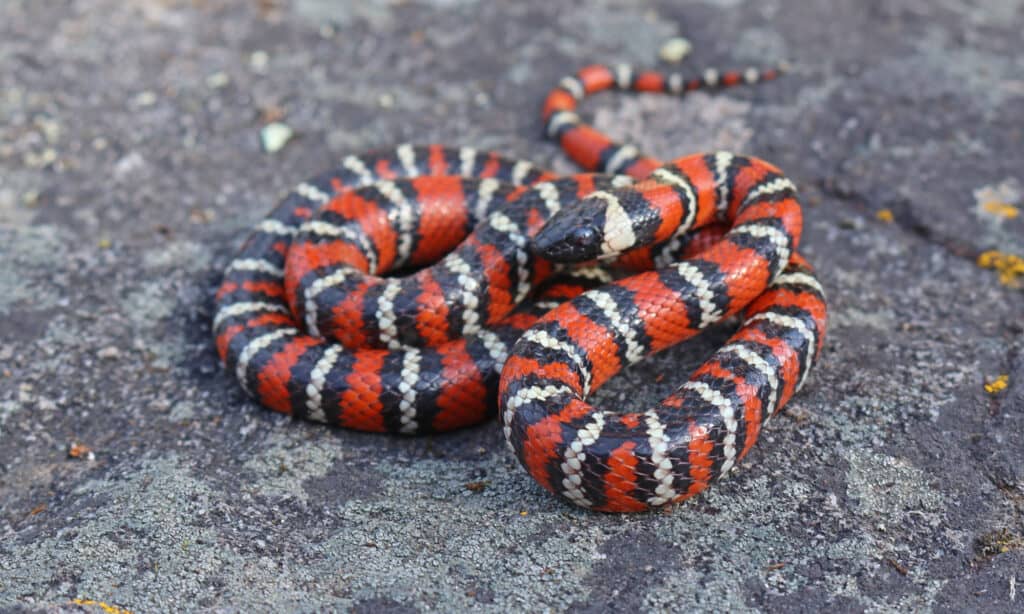
This kingsnake is one of many that mimics the appearance of venomous snakes to protect itself.
©Creeping Things/Shutterstock.com
The California mountain kingsnake is a rarer snake species found in the mountainous regions of California and adjacent states. Its appearance is characterized by vibrant patterns and coloration. The kingsnake’s body features a glossy black color, decorated with bold red, orange, or yellow bands that encircle its length. These bands may vary in width and are often bordered by narrower black stripes, creating a striking contrast that distinguishes it from other snakes.
California mountain kingsnakes are primarily nocturnal, being most active during the night. As skilled predators, they have a diverse diet that includes small mammals, birds, lizards, and other snakes. Like other kingsnakes, they are constrictors, using their powerful coils to subdue and consume their prey.
During the breeding season, females lay eggs in concealed locations. The hatchlings, born with patterns resembling the adults, quickly adapt to their mountainous habitats and begin their independent hunting journey.
The California mountain kingsnake’s striking appearance and ecological significance make it a fascinating species to study and appreciate. Efforts to preserve their natural mountain habitats are essential to ensure their survival and contribute to the biodiversity of the region.
7. Arizona Mountain Kingsnake
Classification: Lampropeltis pyromelana
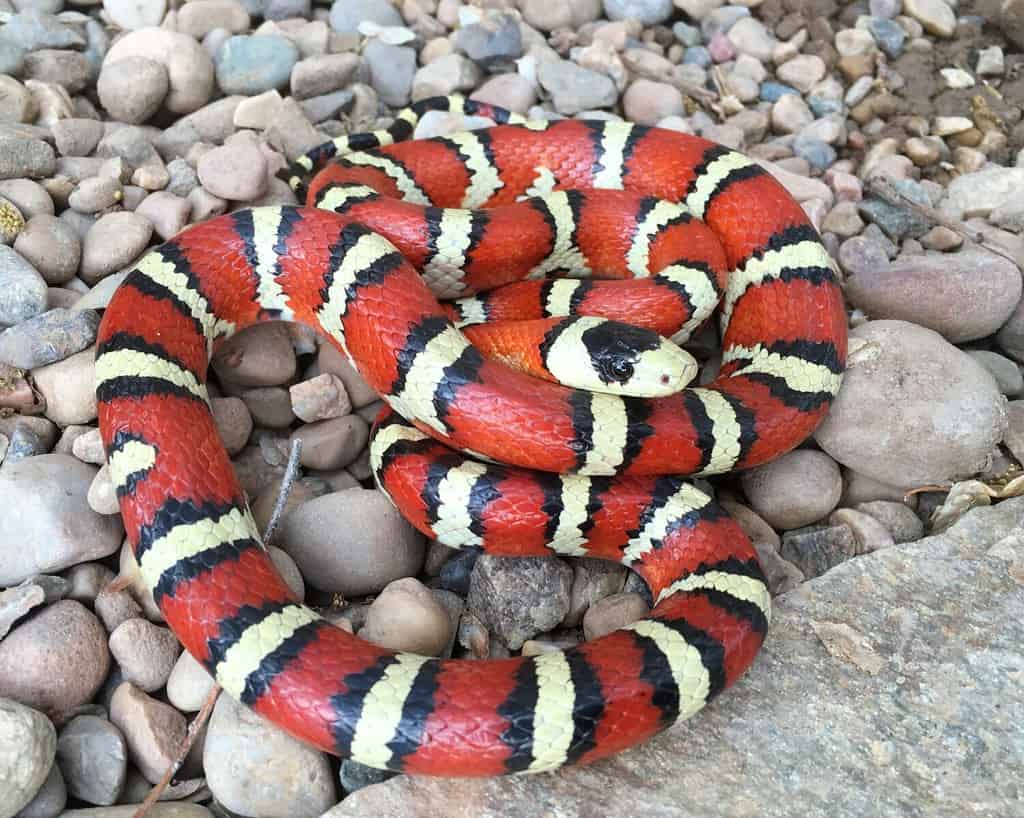
Arizona kingsnakes have bright red, black, and white bands down their bodies.
©Matt Jeppson/Shutterstock.com
The Arizona mountain kingsnake is a fascinating and rare snake species found in the mountainous regions of Arizona and adjacent areas. Its appearance is distinguished by striking patterns and coloration. The kingsnake displays a glossy black body adorned with vibrant red, orange, or yellow bands that wrap around its length. These bands are often bordered by narrower black stripes, creating an eye-catching contrast that sets it apart from other snakes.
Arizona mountain kingsnakes are primarily nocturnal creatures, being most active during the night. They are skillful predators with a diverse diet, which includes small mammals, birds, lizards, and other snakes. As constrictors, they use their muscular coils to subdue and consume their prey.
Like most kingsnakes, when faced with threats, Arizona mountain kingsnakes may exhibit defensive behaviors, such as hissing, vibrating their tails, and coiling to deter predators. Nevertheless, they are generally non-aggressive towards humans and prefer to avoid confrontations.
The Arizona mountain kingsnake’s remarkable appearance and ecological significance make it a captivating species worth studying and conserving. Protecting its natural mountain habitats is crucial to ensure its survival and contribute to the biodiversity of the region.
8. Speckled Kingsnake
Classification: Lampropeltis holbrooki
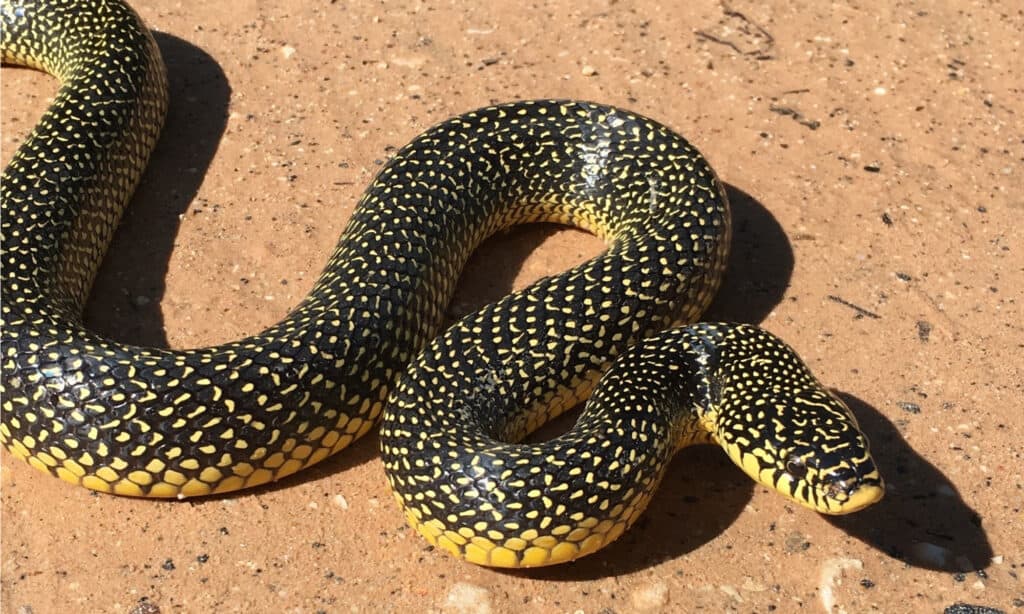
The Speckled Kingsnake has a glossy black body with whitish-yellow dots on its scales.
©Joe Farah/Shutterstock.com
The speckled kingsnake is a type of kingsnake inhabiting the southeastern United States. The kingsnake’s body typically features a dark base color, ranging from brown to black, adorned with numerous small, cream-colored, or yellowish speckles scattered across its scales. These speckles create a mesmerizing and intricate pattern, giving rise to their common name.
Speckled kingsnakes are primarily nocturnal creatures, being most active during the night. As skilled predators, they have a varied diet that includes rodents, birds, lizards, and other snakes. They are constrictors, using their strong coils to subdue and consume their prey.
Despite their non-venomous nature, speckled kingsnakes may mimic venomous snakes to deter potential predators. They may flatten their heads, hiss, and vibrate their tails when threatened.
9. Variable Mexican Kingsnake
Classification: Lampropeltis mexicana
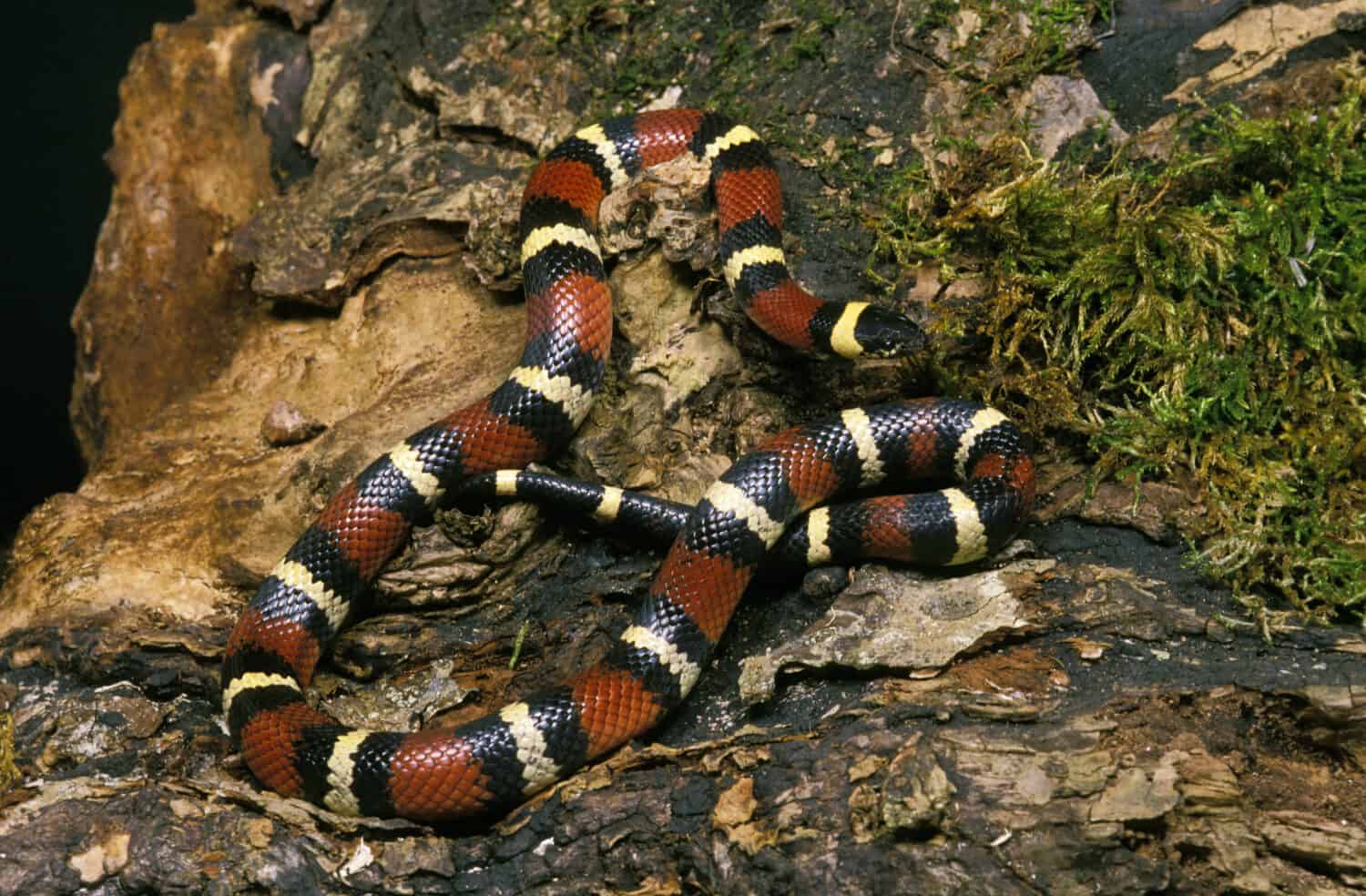
Variable kingsnakes can come in many colors and patterns.
©slowmotiongli/Shutterstock.com
A lesser-known entry on our list of types of kingsnakes, the variable Mexican kingsnake is a captivating snake species found in various regions of North America. Its appearance is marked by striking patterns and coloration, but it exhibits considerable variability in its appearance across different populations. The kingsnake’s body color can range from light gray or tan to rich brown or black, adorned with a diverse array of patterns and markings. Some individuals showcase bold bands or stripes, while others may have speckles or blotches.
Variable kingsnakes are primarily nocturnal, displaying diverse behaviors during their active hours. As proficient predators, they have a diverse diet, including rodents, birds, lizards, and other snakes. Employing their powerful coils, they constrict their prey to subdue and consume it.
10. Scarlet Kingsnake
Classification: Lampropeltis elapsoides
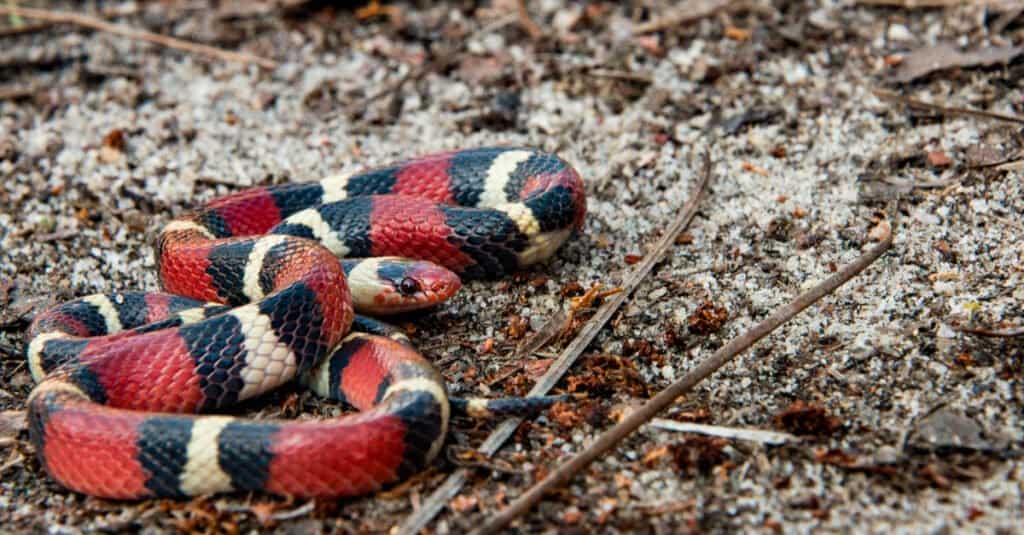
The red-on-black coloring of the scarlet kingsnakes allows for easy identification.
©Jay Ondreicka/Shutterstock.com
The scarlet kingsnake is our last kingsnake species native to the southeastern United States. Vibrant patterns and coloration characterize its appearance. The kingsnake’s body displays a glossy black color, adorned with bright red or orange bands that encircle its length. Narrower yellow or white stripes border these bands, creating a striking contrast that sets them apart from other snakes.
Scarlet kingsnakes are primarily nocturnal creatures, being most active during the night. They are skillful hunters with a varied diet, including small mammals, birds, lizards, and other snakes. As constrictors, they use their muscular coils to subdue and consume their prey.
Despite their non-venomous nature, scarlet kingsnakes may mimic the appearance of venomous coral snakes, a phenomenon known as “Batesian mimicry,” to deter potential predators. This mimicry involves similar band patterns, serving as a warning to predators.
The scarlet kingsnake’s stunning appearance and intriguing mimicry make it a captivating species to study and appreciate. Preserving its natural habitats in the southeastern United States is crucial to ensure its survival and contribute to the biodiversity of the region. This one is one of the most beautiful types of kingsnakes!
Summary of 10 Types of Kingsnakes
| # | Snake | Classification |
|---|---|---|
| 1 | Eastern Kingsnake | Lampropeltis getula |
| 2 | California Kingsnake | Lampropeltis californiae |
| 3 | Mexican Black Kingsnake | Lampropeltis getula nigrita |
| 4 | Desert Kingsnake | Lampropeltis getula splendida |
| 5 | Prairie Kingsnake | Lampropeltis calligaster |
| 6 | California Mountain Kingsnake | Lampropeltis zonata |
| 7 | Arizona Mountain Kingsnake | Lampropeltis pyromelana |
| 8 | Speckled Kingsnake | Lampropeltis holbrooki |
| 9 | Variable Kingsnake | Lampropeltis mexicana |
| 10 | Scarlet Kingsnake | Lampropeltis elapsoides |
The photo featured at the top of this post is © I Wayan Sumatika/Shutterstock.com
Discover the "Monster" Snake 5X Bigger than an Anaconda
Every day A-Z Animals sends out some of the most incredible facts in the world from our free newsletter. Want to discover the 10 most beautiful snakes in the world, a "snake island" where you're never more than 3 feet from danger, or a "monster" snake 5X larger than an anaconda? Then sign up right now and you'll start receiving our daily newsletter absolutely free.
Thank you for reading! Have some feedback for us? Contact the AZ Animals editorial team.







